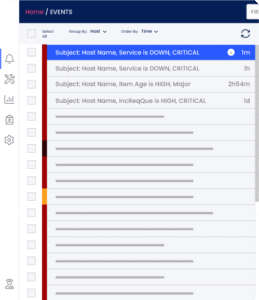What Can Be Done to Support NOC Engineers and SRE Work-Life Balance?
Most cloud applications today require a handful of teams working in the background 24/7 to operate the application’s support infrastructure. Without these teams, customers may face troubles along the way which are typically picked up by the NOC engineers and technicians behind the scenes.
As such, NOC engineers and technicians operating a 24/7 production team face many tensions, while doing their utmost best to keep cloud applications up and running. These tensions do not come at a low cost. In fact, NOC engineers and technicians are known to suffer from inadequate work-life balance and high stress as a result of working shifts around the clock—doing everything they can to keep the company and its business afloat.
Best practices in controllability and observability can help ease tension and create a more supportive and efficient work environment for everyone.
The Day-to-Day Life of NOC Engineers & Technicians
The purpose of a network operations center (NOC) is to keep a business’ cloud and application infrastructure running at maximum capacity at all times while ensuring uptime and availability 24/7.
A NOC’s capabilities can include:
- Managing the monitoring stack
- Managing alerts and incidents
- Remediating issues when possible based on protocols (i.e., runbook/playbook)
- Perform proactive tasks such as system checks
- Perform root cause analyses
- Provide reports on the solution’s uptime, availability, and resilience
NOC engineers and SRE teams are responsible for managing and handling any issues as they arise. Their typical duties include supervising every business flow, application, cluster, server, and endpoint connected to the cloud environment. They have to classify all alerts in order to understand the type, severity, and importance of each event. NOC engineers, SRE, and shift supervisors must have extensive knowledge of procedures and technical issues to perform their duties efficiently while being available to monitor their cloud solutions 24/7, which means they’ve got a lot on their shoulders and the pressure to not make mistakes is high.
Challenges of Scaling a 24/7 Cloud Production Environment
Although NOC engineers and SRE deal with operational and computational matters, the human factor in this operations environment is critical.
These 24/7 teams are measured by their failures, i.e, the errors that come up, crashes, and issues, and how they deal with them—not by successes because when everything goes well, there is nothing to measure.
Moreover, it is difficult to keep a healthy work-life balance while scaling a 24/7 cloud production environment, and the heavy weight lifting falls mostly on the shoulders of NOC engineers. Hence, it is imperative to create an environment that keeps them empowered, engaged, and trained. Expecting a production environment that runs 24/7 to not only operate smoothly but also scale (in line with the company’s business objectives), is a serious challenge.
From the software development cycle to testing and production – many things can go wrong. Not to mention, deployment on the customer side can involve its own set of problems too. At the end of the day, what service providers are most interested in is offering customers a cloud application that runs seamlessly, day and night.
Some of the biggest challenges in scaling a production environment involve:
- Slow production speeds (production)
- Limited capabilities in data preparation and design (software development)
- Part-to-part variation (QA)
- Lack of industry-wide standards
- Lack of understanding and expertise
- Making the initial investment (financial)
- Disjointed AM ecosystem (workflow and integration)
- A lack of digital infrastructure
To tackle these challenges, a combination of efforts needs to be made, and a lot needs to be done: investing in the right resources and tools, developing standards, creating expertise, enhancing software development and QA capabilities, optimizing workflows, integration, and the available digital infrastructure, and much more.
One place to start is by implementing the best practices of controllability and observability into your production environment. Whether you’re a NOC engineer, technician, DevOps engineer, or site reliability engineer (SRE), implementing controllability and observability into your production environment can not only optimize it – it can also help you scale the production environment.
Why Controllability & Observability Play a Key Role in Scaling Production
The people who typically manage and maintain the production environment are the DevOps and SRE engineers, as they all work to combine the development and operation teams, introducing visibility into the entire application lifecycle while helping developers to see the other side of the process.
They are advocates of automation and monitoring, with a similar goal to reduce the time from when a developer commits a change to when it’s deployed to production. Furthermore, they want to do so without compromising on the quality of the code or product along the way.
Introducing controllability and observability to the production environment provides a quick and easy solution for the 24/7 teams operating this environment—controllability enables more automation while observability allows for further monitoring.
To better understand what controllability and observability are, we invite you to read our previous blog post: What Is the Controllability and Observability of Cloud Applications?
When you implement controllability and observability, you are allowing your teams to optimize their existing processes, ensuring that the production environment is functioning optimally, and allowing your team to manage their time in a way that provides them with a healthier work-life balance.
Scaling Production Environment & Supporting 24/7 Teams With MoovingON.ai Platform
Implementing controllability and observability starts with finding the right platform.
An effective system will offer added value in the form of an extra layer of monitoring, where IT Ops can have access to a comprehensive “big picture” of production issues and an application. This can happen by the aggregation and display of analytics, logs, traces and alerts in one place, which enables the IT Ops to fix issues, pinpoint where the problems occur, better understand them, and improve overall services.
By being proactive, one can potentially foresee any potential issues before they may occur. Doing so will help identify and solve issues regarding production. It can also help increase the pace of the processes and releases, plus the ability to track and update any changes. To achieve this at the NOC level, we want the ability to efficiently manage the NOC environment with the development and customer deployment of the cloud application.
That’s where MoovingON.ai platform comes in; a SaaS-based SRE/NOC management platform that centralizes and manages all aspects of your operational environments.
Get in touch with our team for more information about our platform.


